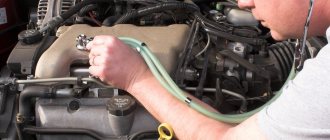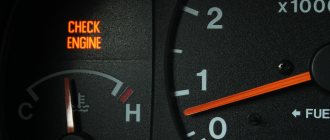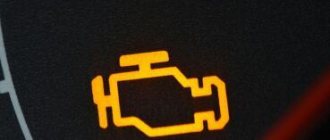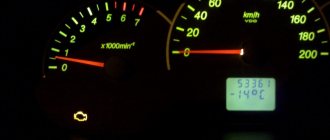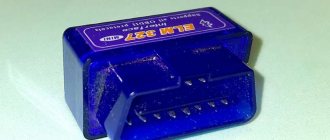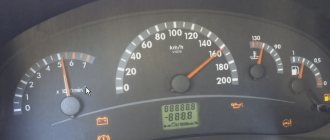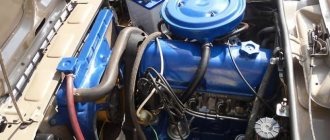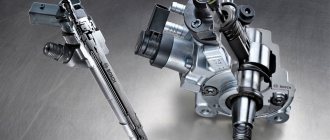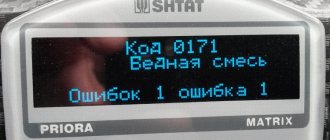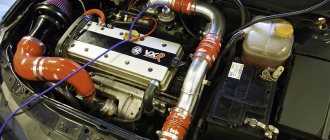Reasons for Check Engine
The engine icon on the instrument panel lights up and the driver begins to panic. Why does the check light come on and what should I do? There is a story circulating among car enthusiasts on this topic: the Check Engine icon lights up - the intuition show begins. But not everything is as bad as it seems at first.
The check engine icon on the dashboard signals that there are faults in the power unit, while the electronic control unit analyzes the data received from the sensors and gives a signal that the fault needs to be repaired.
Before you start panicking, you need to understand the problem. The easiest way to find faults is to connect directly to the ECU and read the errors that are there. By deciphering the error, you can narrow down the troubleshooting area. So, the Check Engine light is on, maybe it’s a faulty sensor, and there’s nothing critical.
But a burning Check Engine sign may also indicate that the power unit has more serious faults than a banal failed sensor. That is why, after the Check Engine icons light up, you must immediately contact specialists at a car service center.
Let's look at the main list of problems that may cause the Check sign on the device to light up:
- Poor quality fuel.
- Spark plugs or high voltage wires.
- One of the sensors is faulty.
- Fuel pump and filter.
- Air supply system to the cylinders.
- ECU and wiring.
- Other malfunctions.
Why is error 8 associated with problems with the brake system?
Some car enthusiasts incorrectly interpret the message with error 8, believing that it is necessary to check the brake system. This is due to the fact that on VAZ cars this fault number indicates an insufficient level of brake water.
The Chevrolet Niva's on-board computer uses other designations, so you should not interpret them in the same way as in the VAZ. If you doubt the condition of the brake system, you can check it during the repair process. Before all this, pay attention to the brake water level, and then check the pads.
Source: ladaprofi.ru
Troubleshooting Methods
Now that the main reasons have been identified - why the Check caught fire, you can move directly to methods for solving the issue. Of course, it is best to contact a car service to solve the problem, but many motorists, due to expensive repairs, try to solve the problem themselves.
So, before you start looking for a problem, you should connect to the electronic engine control unit and conduct a comprehensive diagnosis of all systems. To do this, you will need a laptop computer, a cable for connecting to the OBD 2 car and software that is suitable for this electronic control unit.
Having connected to the vehicle, it is necessary to carry out a comprehensive diagnosis of all systems, and then determine which errors have popped up and decipher them in order to determine the fault point. When everything is deciphered, you can proceed directly to troubleshooting.
Poor quality fuel
One of the most common reasons why the Check icons light up is low-quality fuel, which can often be found at gas stations. Thus, bad gasoline or diesel can clog fuel lines and its elements, which leads to effects such as tripping or stalling of the engine.
To fix the problem, you will have to drain the fuel from the entire system. It is worth noting that this process is quite labor-intensive and requires some knowledge in car design. Thus, you will have to remove the fuel tank and wash it, as well as replace elements that have become unusable.
Fuel pump and filter
Along with low-quality fuel, the fuel pump and filter suffer. Basically, the contamination of these elements leads to the fact that fuel does not flow in the required quantity, and this in turn leads to the appearance of a lean mixture, which can lead to high consumption or poor engine starting.
To eliminate the problem, you will have to replace the fuel filter. As for the gasoline pump, you will have to remove it from the car and replace the filter mesh, which is probably clogged. This procedure must be performed carefully, since you can accidentally damage the elements of the fuel pump.
Injectors
Another fuel element that is susceptible to low-quality fuel is the injector. Clogged elements can cause the engine to run rough. That is why this element occupies a high place in diagnostics.
In order to diagnose and eliminate the malfunction, you first need to remove the elements from the vehicle. Of course, some motorists recommend diagnosing and cleaning injectors directly on the car. But, to perform this operation, there is a special stand for washing injectors.
The injectors are disassembled and the nozzles are removed from them and installed in the stand. First, using different pressures, it is checked whether the nozzle is suitable for use. Then, if necessary, the element undergoes a cleaning process or is replaced with new ones.
Ignition system
Spark plugs and high-voltage wires also do not last forever. They tend to wear out, especially when the car owner does not carry out maintenance on them. One faulty wire and spark plug can be the reason why the Check sign is on.
NIVA.RU
NIVA car owners community forum
- Unanswered topics
- Active topics
- Search
New Niva.. The check light came on at 60 km.
New Niva.. The check light came on at 60 km.
Post by flatraaa » 04 Feb 2013, 22:50
Re: New Niva.. The check light came on at 60 km
Post by Warlock » 04 Feb 2013, 23:01
Re: New Niva.. The check light came on at 60 km
Post by flatraaa » 04 Feb 2013, 23:40
Re: New Niva.. The check light came on at 60 km
Post by Warlock » 04 Feb 2013, 23:49
Re: New Niva.. The check light came on at 60 km
Post by flatraaa » 05 Feb 2013, 00:00
Re: New Niva.. The check light came on at 60 km
Post by Warlock » 05 Feb 2013, 00:09
Re: New Niva.. The check light came on at 60 km
Post by ParaLanik » 05 Feb 2013, 00:22
Re: New Niva.. The check light came on at 60 km
Post by Sunny » 05 Feb 2013, 07:23
Re: New Niva.. The check light came on at 60 km
Post by Sash » 05 Feb 2013, 11:07
Re: New Niva.. The check light came on at 60 km
Post by Sunny » 05 Feb 2013, 12:13
Re: New Niva.. The check light came on at 60 km
Post by Sash » 05 Feb 2013, 15:43
Re: New Niva.. The check light came on at 60 km
Post by flatraaa » 05 Feb 2013, 19:49
Re: New Niva.. The check light came on at 60 km
Post by flatraaa » 05 Feb 2013, 19:54
Re: New Niva.. The check light came on at 60 km
Post by Valkin » 05 Feb 2013, 20:54
Re: New Niva.. The check light came on at 60 km
Post by Warlock » 05 Feb 2013, 21:00
Re: New Niva.. The check light came on at 60 km
Post by Warlock » 05 Feb 2013, 21:07
Re: New Niva.. The check light came on at 60 km
Post by Valkin » 05 Feb 2013, 21:15
Re: New Niva.. The check light came on at 60 km
Post by flatraaa » 05 Feb 2013, 21:49
Re: New Niva.. The check light came on at 60 km
Post by boczman » 05 Feb 2013, 22:18
Re: New Niva.. The check light came on at 60 km
Post by Warlock » 05 Feb 2013, 22:57
Consequences of late diagnosis and repair
What could be the consequences of untimely elimination of the Check Engine? The list here can be quite long. Let us describe the main reasons and problems:
- The failure of one element can lead to a chain reaction that will lead to more complex consequences.
- The occurrence of tripping effect, poor starting, system failure, increased consumption and other similar malfunctions.
- Overheating of the power unit, and as a result, deformation of the cylinder head. Then only a major overhaul will follow.
- The ECU receives unreliable data, and, accordingly, incorrect operation of other main and auxiliary systems.
- Other consequences.
Conclusion
The Check Engine light on the engine dashboard means that a problem has occurred that should be repaired immediately. So, before looking for a mechanical failure, it is recommended to diagnose the software and determine exactly where the problem is hidden. Only after this should you look for a mechanical problem.
A car malfunction is unpleasant. A breakdown will occur unexpectedly if you do not take care of the car and do not heed warnings. One of them is the “Check engine” light. How to understand what the problem is, what it indicates and what to do if it lights up.
Purpose of the button
The instrument panel in a car is a way for the driver to monitor the level of gasoline, oil, engine operating condition or other components of the car, which guarantee comfortable and silent driving on the road.
Modern cars are equipped with an indicator necessary for the convenience and comfort of the driver. If earlier an engine malfunction had to be found only visually or by carefully listening to the operation, today a special light bulb works. It is created for the convenience of monitoring the engine condition. Ideally, it should light up only when the engine starts and go out after a couple of seconds.
How serious can the reasons be?
Each signal on the car panel is an indicator that the driver must be attentive. When the check engine light comes on, there are several reasons.
- A common cause is gasoline. Due to the additives that unscrupulous manufacturers use in gasoline, the engine does not work properly and becomes clogged. You should change the fuel or refuel at another gas station, and everything works correctly.
- Faulty spark plugs.
- Broken ignition coil.
- A faulty oxygen sensor (lambda probe).
- Broken exhaust catalyst.
- Incorrect operation of high-voltage conductors.
- Malfunction of injectors.
- Fuel pump or fuel filter.
The check should begin with the fuel tank filler cap. If it is not tightened completely or there are defects on it, then the light indicates that the engine is not operating properly.
Find out how to overcome your fear of driving and gain self-confidence here.
Each of the reasons is not very scary, but requires immediate elimination. If you do not pay attention in time and do not diagnose the malfunction, you can lead to complete engine failure and incapacity of the machine.
The engine is serious business, but the job doesn't necessarily require a major overhaul or engine replacement. The work of the craftsmen is important in any matter of diagnosing and repairing the engine. But, if the reason is candles, then the replacement is carried out independently and quickly, without the involvement of specialists.
A few words about how the battery-generator tandem works
Everyone, even a novice driver, knows that the battery interacts with the generator. After starting the engine, the battery goes into constant charging mode. After the engine speed increases, the voltage at the generator output also increases, which is not a “hum”.
In order to prevent the above described, a small relay-regulator is installed in the rotor excitation circuit, the task of which is to reduce the current to the optimal level, regardless of the engine speed. As a result, the voltage is maintained at the required level. The battery light comes on when there is no charging from the generator.
So, let's simulate the situation. You started the engine, but the battery light did not go out. What's the matter?
- Faulty relay-regulator, diode bridge;
- Poor tension of the generator belt, critical wear or belt slippage. Wear (play) of the generator bearing;
- Blown fuse or poor contact;
- Poor contact at the battery terminals, at the generator terminal or at the ground wire;
- Open circuit of the generator excitation circuit, serious wear of the generator brushes or brush holders;
- Wearing out the ignition switch is an option, but in this case several lights will light up at once.
What to do if the light comes on
If you see that the check engine light does not light up as it should (does not go out after starting the engine or lights up when driving), then you should stop to diagnose the car. This may not be done right away, but it is necessary. Remember, if it lights up, this is the reason, either go to a service station for diagnostics, or check the engine for faults.
The first thing you can do when the light comes on is to stop and listen to how the engine is running: is there any vibration, or any extraneous noise or knocking. If you hear extraneous sounds, they will indicate the cause of the breakdown to an experienced driver. If the cause of the breakdown is not clear to you, the direct route is to the nearest service station.
If the cause of the light coming on is poor-quality fuel (this can be determined after diagnostics, after eliminating other causes), then the service technicians will tell you that it is worth changing the type of fuel you fill in the car or the place where you are used to refueling.
- Oxygen sensor. It is worth replacing it yourself, following the operating instructions for a car of a particular brand. If the replacement is not made in time, there will be excessive fuel consumption and the catalyst may break, the replacement of which will be much more expensive.
- A leak in the fuel tank is the cause of air getting inside, which means excess consumption. It is worth either replacing the lid or achieving a tight seal using gaskets.
- Candles. This is the main element that guarantees the combustion of the fuel mixture. If they do not work correctly, then the car will refuse to work at all. Replacing spark plugs is not difficult if you are already an experienced driver. You can change either only the spark plug that has already served its purpose, or all at once, in order to definitely avoid problems with the car. It’s worth buying a set of spark plugs specifically for your car at the store. If you are not sure that you will buy the right option and be able to replace it, then go to a service station, they already have the parts you need and specialists will be able to make the replacement quickly and affordably. When it comes to spark plugs, it is worth remembering that old-style cars require replacement every 20,000 km, and if the car is new, then it can travel up to 150,000 km on the same spark plugs. If you change spark plugs on time in accordance with the technical operation requirements of your car, then you can avoid catalytic converter breakdown and improve engine performance.
- Replacing the mass air flow sensor. This part regulates the amount of air needed for rapid ignition. When it is faulty, it results in excessive fuel consumption, an increased amount of carbon dioxide in the exhaust, poor acceleration, and a decrease in engine power. Most often, the breakdown is due to an incorrectly installed air filter or the filter's operating time has already expired. When it comes to changing a sensor, the costs are related to the price of the sensor itself, but the replacement service is not so expensive because it does not require much time and is simple in technology. Regular filter replacement guarantees long-term operation of the sensor .
Nuances in the operation of the “Check engine” light
The check engine light on the dashboard appeared in the early 90s. but then the work of the sensor was aimed only at monitoring the operation of the carburetor. That is, the light came on when:
- There was a blockage;
- The combustible mixture for engine operation was incorrectly prepared, etc.
Today, the work of a light bulb is much broader. There are no carburetors in new-style cars anymore. Injectors are installed instead. It is in connection with this new feature in the car that the light shows not only the wrong mixture. Thanks to it, the driver learns about:
- Business interruptions;
- Ignition problems;
- Poor gear shifting and more.
See what else a burning check engine light may indicate (video)
Thus, thanks to such a light on the panel, you can monitor almost every element of the engine, its condition and performance.
The engine control light on the driver's panel is a status indicator. If it does not burn according to the rules, then you should pay attention to this and go for diagnostics. Timely repair of a breakdown is a guarantee of safety and comfort on the road. Paying close attention to your car will prevent it from breaking down at the most inopportune moment.
It often happens that an emergency sensor light comes on on the instrument panel in the interior of a car equipped with electronic control. If the car starts up and continues to work, but the check engine light comes on, this means that it was turned on in emergency mode. Some models of modern cars (Audi, BMW, Mercedes-Benz, Porshe, VW) are equipped with a system capable of self-diagnosis; errors in decrypted form are sent to the information panel. But drivers are not always able to understand why the check engine light came on.
Replace the oxygen sensor (lambda probe)
The oxygen sensor in your car is part of the exhaust system that monitors how much oxygen is not burned in the engine combustion chamber. This sensor helps control the vehicle's fuel consumption. A malfunction of the oxygen sensor (lambda probe) means that the car computer does not receive the correct data and can significantly increase fuel consumption, and at the same time reduce engine power. Most cars have 2 to 4 oxygen sensors. If you have a home car error scanner, then by connecting it to the car you can easily find out which sensor needs to be replaced.
For what reason does the oxygen sensor in a car become unusable: - Over time, the sensor becomes covered with a layer of used and regular motor oil (oil soot), which reduces the accuracy of reading sensor readings for regulating the gasoline mixture and distributing optimal fuel consumption. A malfunction of the oxygen sensor in a car leads not only to increased fuel consumption, but also to an increased content of harmful CO2 substances in the exhaust.
What needs to be done: -If you do not change a faulty car oxygen sensor, this may lead to failure of the car catalyst (it may burst), which will result in expensive repairs for you. The cost of new catalysts is very high due to the precious alloys they contain. Some cars have several of these catalysts at once and their cost can reach up to 90 thousand rubles. So gentlemen, don’t delay replacing the oxygen sensor. Although replacing the sensor itself and its cost are decent, it is still not commensurate with the cost of the exhaust gas catalyst system itself. You can save money on replacing this sensor by doing it yourself. Many car manuals have detailed instructions on how to replace the oxygen sensor yourself. If you know where the oxygen sensor is located, then it will not be difficult for you to disconnect the faulty lambda probe and replace it with a new one. Remember that you cannot delay replacing this important element!
What does the Check Engine light mean?
To start the engine, the driver turns on the ignition. If the check engine light is flashing at the same time, this should not cause concern, since it will soon go out. But a burning signal while the engine is running indicates problems with its operation.
If a malfunction occurs in the operation of the power unit, an error is recorded in the memory of the control unit in the form of a coded signal. In this case, the check engine light appears on the dashboard. If the car does not have diagnostics in automatic mode, you need to connect a scanning device to a special connector. The scanner reads the code and provides a detailed explanation of the error.
Signs of main malfunctions and reasons for the appearance of the indicator signal
If the Engine check light comes on while the car is moving after refueling at a gas station, the most likely reason is inappropriate quality of the gasoline poured. The following symptoms are observed:
- Reduced power.
- Interruptions in engine operation (stalls).
- Detonation as a result of incomplete combustion of fuel.
To correct the situation, it is recommended to do the following:
- add a portion of higher quality fuel to the tank;
- Drain the recently filled gasoline and clean the fuel system.
If the check does not want to go out after the cause has been eliminated, you need to delete the error recorded in the device’s memory using a special computer program.
Reasons why the Chevrolet Niva engine fails
Timely diagnosis of the ignition or fuel supply system will avoid serious problems with the engine. There may be several reasons for unstable operation.
- No ignition.
- Early or late ignition of fuel.
- Rich or lean fuel mixture.
- Low compression.
Some of the listed reasons can be eliminated on your own, even far from home. Other causes require specialized diagnostics. It is recommended to look for the cause using the method of exclusion.
Checking the oil level and condition
The next most important reasons for the signal are considered to be overheating of the motor and a decrease in the level of lubricating fluid in the internal combustion engine. It is recommended to check the engine temperature. If there is no overheating, you need to check the volume and condition of the oil. After checking the level, it is necessary to add the missing amount of lubricant. Using a clean paper napkin, the quality and composition of the engine oil is checked according to the following criteria:
- Color.
- Consistency.
- Presence of mechanical inclusions.
- The smell of burning.
If everything is in order with the quality and quantity of oil, the engine starts to eliminate unusual sounds and noise when operating both at idle and under load.
If unusual noise effects of a running engine are detected against the background of a burning check, it is recommended to send the car to the nearest service company. Moving the car yourself is not recommended; delivery is carried out by towing or other convenient method. Further operation can lead to serious damage and costly repairs to the elements of the power unit.
When can you continue moving with this indicator, and when not?
You need to understand that the consequences for the further operation of the car depend on the correct actions of the driver at the moment the “Look at Engine” light flashes. The glow of the self-diagnosis element when the power unit is running tells the car owner that the on-board computer or engine control unit has detected a malfunction.
The check engine LED came on. What to do?
You are allowed to continue driving if the indicator is constantly on (not flashing) and there have been no noticeable changes in the operation of the vehicle. It also responds instantly to sudden pressure on the accelerator pedal. There is no loss of power observed. The oil level in the engine crankcase and antifreeze in the cooling system are normal. The remaining self-diagnosis lights do not light up. You need to get to the nearest car service center to use computer diagnostics to determine and correct the cause of the failure in the control system.
But if negative changes in the operation of the car begin to be observed: the engine power has decreased, suspicious knocking and vibration appeared, a burning smell began to be felt, and the Check engine light is blinking - further movement is prohibited. The engine must be turned off immediately to avoid serious consequences. Suspicion of overheating of the power unit, a drop in pressure in the engine lubrication system and other reasons can lead to breakdowns that will require a lot of money, time and effort.
Flashing indicator and engine tripping
When the check engine light flashes and the engine starts at the same time, it is necessary to inspect the elements of the ignition system:
- spark plug;
- wiring;
- coil.
The tripling effect occurs when only three combustion chambers are firing instead of all four. The engine begins to stall when there is no injection of the air-fuel mixture into one cylinder.
Worn out and dirty spark plugs can also cause the Check Engine light to turn on. In order not to think for a long time about how to remove the check engine light, you just need to clean or completely replace the outdated spark plugs with a new set.
If the check is blinking and the engine is shaking, it is recommended to inspect and check the integrity of the high-voltage wiring, the quality of contact connections, refresh the insulation in places of breakdowns, and replace burnt wires leading to the glow plugs.
Testing the ignition coil comes down to measuring the resistance at the terminals and testing for the ability to create a blue spark.
Replacing brushes or the generator itself
Current collection brushes wear out most often, so here is a description of how to do this job:
- Remove the negative terminal from the battery and disconnect the wires leading from the generator casing.
- Remove the protective cap from the terminals of the positive terminal of the wires. Unscrew the nut that secures the block to the generator block.
- Disconnect the spring clips and remove the dark plastic case.
- Unscrew the voltage regulator mountings with a Phillips screwdriver. Take it out together with the brushes.
- Disconnect the wires from it. Remove the assembly together with the fastening bar, take off the belt.
- Release the generator from the bracket by unscrewing all the mounting bolts.
The upcoming action plan depends on what you will change. If the brushes are very worn, they need to be replaced. If the current collectors are visually intact, then the reason may be in the remaining parts of the generator. Almost always, car enthusiasts simply change it completely.
What to do if the check engine light comes on due to a malfunction in the fuel supply system
In case of problems associated with the flow of fuel into the cylinders, it is recommended to check the condition of the spray nozzles. Their holes must be cleaned, washed, and, if necessary, completely replaced with new devices.
A decrease in pressure in the fuel system is caused by malfunctions:
- Gasoline pump (in carburetor, injection engines).
- Fuel filter
- Injection pump pump (in diesel).
If the check light is caused by a failed catalytic converter, drivers simply remove it from the exhaust system and then disconnect the corresponding sensor (oxygen).
How to reset check engine error
If critical errors occur in engine operation, the information is recorded in the ECU memory and is not deleted independently even after the defect is eliminated. At the same time, the check remains illuminated. To reset a recorded error with your own hands, experienced car owners perform the following operations:
- warm up the engine to operating temperatures;
- disconnect the terminal on the battery for a while (from 5 to 15 minutes);
- restore the connection with the terminal;
- insert and turn the ignition key before starting (all the indicators on the devices are lit);
- wait one minute;
- turn the key in the opposite direction.
Most often, such actions lead to the desired result; the error code disappears from the memory of the ECU. The check stops lighting after the engine is turned on and idled for three minutes.
If the method of disconnecting the terminal does not work, the indicator continues to blink, the error is removed from the memory of the control device using special computer programs through the OBD pinout diagnostic connector.
The control unit can also cause the check signal to turn on if individual elements of the computer partially or completely fail.
Self-diagnosis
If it is not possible to check with a special device, then this can be done using self-diagnosis, which will help to quickly identify all problems associated with the operation of the car. To do this, press the odometer button and turn on the ignition. The speedometer needle will begin to rise to the top; by pressing again, information about the firmware will appear on the screen, and by pressing again, all existing errors will appear.
Let's take a closer look at the Chevrolet Niva error codes with decoding:
During self-diagnosis, error 8 and error 14 often appear, the first informs about problems in the brake system, and the second is related to fuel consumption, quite often this is a system glitch, but in any case you need to replace the sensor responsible for these mechanisms, or reset the memory by resetting the battery terminals.
